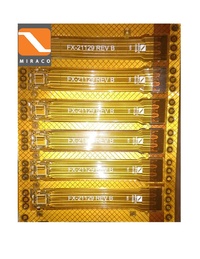
Photo from wikipedia
Dear editor, The interactive integration of humans and information demands stretchable and flexible electronic systems. A new type of electronic technology that was both portable and comfortable appeared in the… Click to show full abstract
Dear editor, The interactive integration of humans and information demands stretchable and flexible electronic systems. A new type of electronic technology that was both portable and comfortable appeared in the early 1990s [1, 2] and gained widespread application [3,4]. In recent years, flexible electronic technology has been applied and developed in many sectors leading to lifestyle changes globally. In a flexible inorganic electronic system, the electrical properties of stretchable interconnects are affected by the strain on these interconnects. Signals take some time to be transmitted from one end of an interconnect to the other, causing a delay in signal transmission. This delay dramatically affects signal integrity as products reach smaller physical sizes and faster signal speeds. The shape of stretchable interconnects is similar to that of a serpentine line. As the distance between parallel strip lines decreases, the delay in a serpentine line decreases due to the effect of mutual inductance and can be much smaller than that in a straight line of the same length [5, 6]. For stretchable interconnects, crosstalk problems can occur between two symmetric segments in repeated units of the stretchable interconnects due to this special shape. The direction in which crosstalk noise leaps is the same as the original signal propagation direction. Therefore, compared with a straight interconnect of the same length, the noise-added signal in a stretchable interconnect arrives early. During the deformation of stretchable interconnects, parasitic parameters change as the shape changes, which affects the crosstalk noise and thereby varies the delay. The flexible electronic design platform is used to analyze the delay associated with stretchable interconnects. The simulation for this analysis has three steps. First, the structure of the stretchable interconnect is defined in the platform and mechanical analysis is conducted to extract the associated deformation model in ANSYS. Second, the deformation model is imported into the ANSYS Q3D Extractor to extract the parasitic parameters and the Q3D model according to the shape of the three-dimensional structure. Finally, the required circuit is initialized and simulated in the Advanced Design System (ADS) to get the delay in stretchable interconnects in terms of the step response. The Elmore model has become the most commonly used interconnect-delay model owing to its fast computing speed [5]. However, the Elmore delay model only considers the influences of resistance and capacitance [7]; hence, this model cannot describe the effects of deformation on the delay of stretchable interconnects. In flexible electronic systems, parasitic parameters of interconnects change during the stretching and bending process. Herein, based on the traditional delay model for electronic systems, a new delay model for stretchable interconnects is proposed to ana-
Journal Title: Science China Information Sciences
Year Published: 2018
Link to full text (if available)
Share on Social Media: Sign Up to like & get
recommendations!